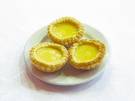
Chinatown New York City’s markets offer the freshest and most diverse selections of produce, tofu, meats, seafood and spices -- many of which can only be found in Chinatown. New Yorkers who have not yet discovered the benefits and cultural experience of shopping in a Chinatown market are sure to be pleasantly surprised with the variety and high-quality of goods, not to mention the bargain prices.
Vegetables and Fruits
Looking for lotus roots? Winter melon? Perhaps some baby bok choy or fresh tofu for your favorite dish? Hard-to-find items such as Chinese turnips (only around 60 cents a pound!), and rare lily bulbs from China can be found in Chinatown’s bustling markets. Those who love Asian-cooking will also love the wide array of choices when it comes to Chinese vegetables and herbs. Delicious Chinese vegetables such as
choy sum (a flowering cabbage with tiny yellow flowers),
bok choy (Chinese cabbage),
guy lon (Chinese broccoli), and
guy choy (Chinese mustard greens) are widely available in Chinatown. Oranges and apples sound mundane? Take a break from the usual choices and shop for tropical fruits and rare fruit varieties.
Fresh Vegetables: okra, winter melon, bitter melon, peapod leaves and taro
Preserved Vegetables: snow cabbage, preserved radish and pickled vegetables
Fruits: durians, star-fruits, dinosaur eggs (dapple dandy) lychee, longan, dragon fruits, kumquats and persimmons
MeatsFor those who crave lap cheung (Chinese preserved sausage) or Chinese roast duck, look no farther than Chinatown, a Mecca for meat-lovers. Here, expect to find all types of meats selling at affordable prices, ranging from Chinese roast pork to white Peking duck as well as cuts of meat that are not generally available at American markets. Meats include: roast duck, roast pork, chicken, goose, tripe and liver.
SeafoodOne of the highlights of Chinatown’s markets is the live seafood showcased in tanks. Live lobsters, fish, crabs, prawns, and even sea cucumbers are a delightful sight for seafood connoisseurs. Prices for seafood in Chinatown are among some of the lowest in New York. Seafood includes: grouper, sea cucumber, sea fungus, fish balls, squid, octopus and shellfish.
Chinese Dried Ingredients, Sauces and Spices
Hard to find dried ingredients for soups, sauces and stews are also available at most Chinatown markets. Visitors will notice the alluring barrels in front of these markets that are filled with dried goods such as ginseng, abalone, squid, scallops, jellyfish, stingray, salty fish, Chinese black mushrooms and bean curd. These are often used as a base for soups, stews and sauces.
Asian sauces give food a distinct Eastern flavor and Chinatown markets offer an array of sauces for cooking including a selection of soy sauces, oyster sauce, chili sauce, preserved black bean sauce, shrimp paste and fermented bean curd sauce.
Impress guests or spice up a home-cooked meal by cooking with a variety of Asian spices such as five spice powder, star aniseed powder, Szechuan pepper, dried orange peel, black sesame seeds and brown peppercorn.
Next time I will post a list of markets where you can do your shopping!












